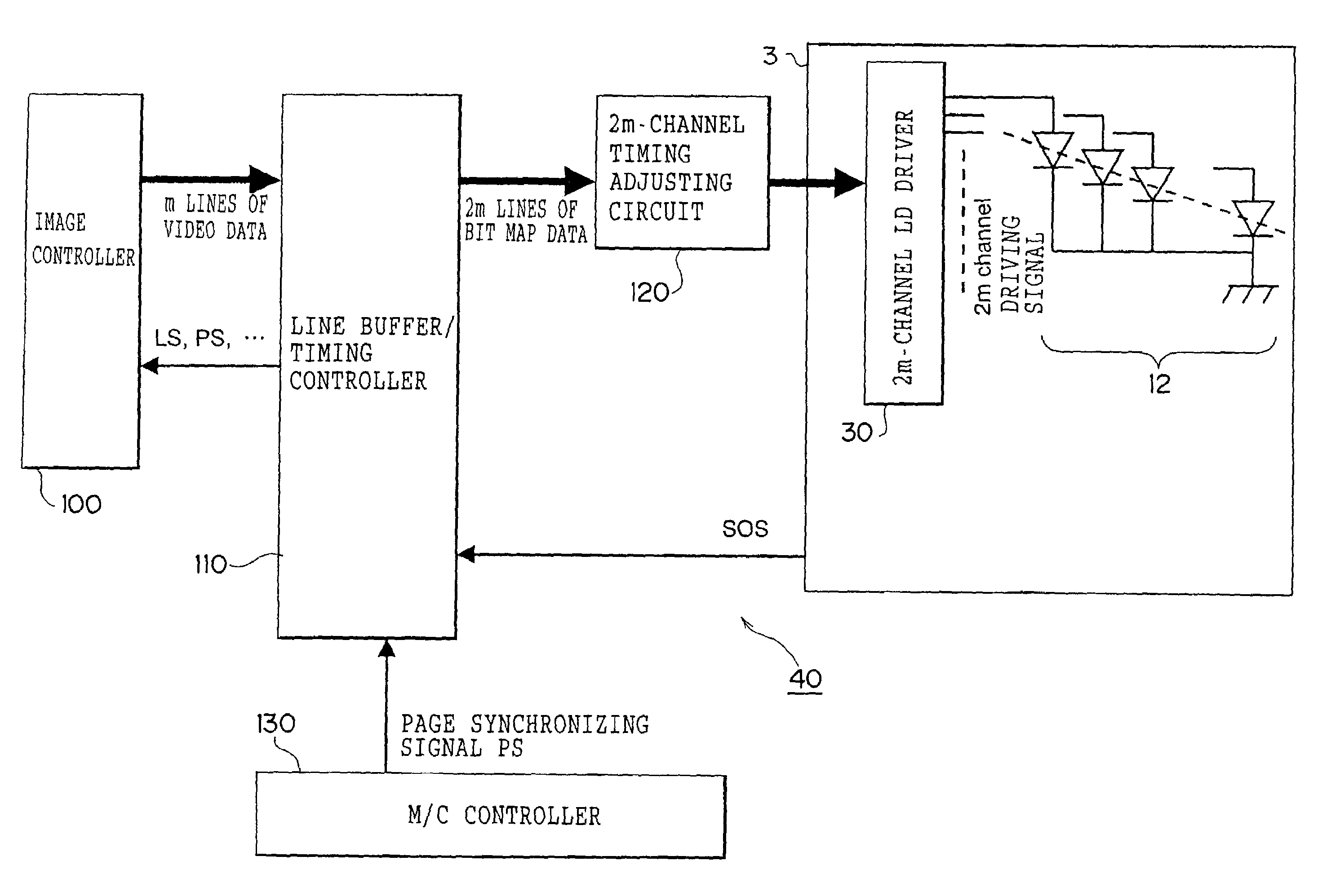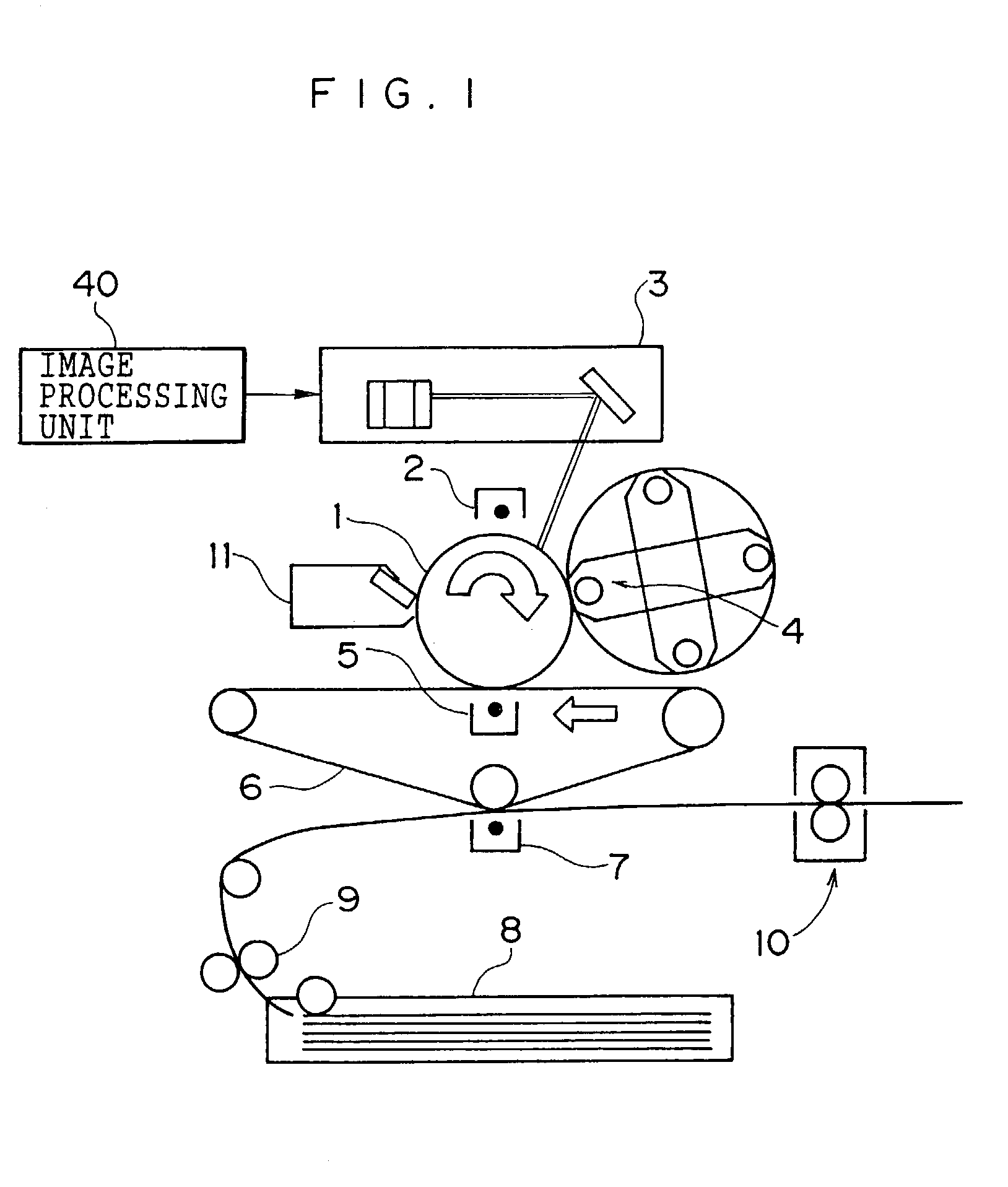Method and apparatus for reducing the visibility of streaks in images generated using scanning techniques
a scanning technique and image technology, applied in the field of image forming apparatus, can solve the problems of difficult to implement an analog circuit changing the light emitting quantity at high speed, the speedup of the rotational speed of the polygon mirror and the video clock is in a difficult state, and the degree of freedom of image forming can be increased
- Summary
- Abstract
- Description
- Claims
- Application Information
AI Technical Summary
Benefits of technology
Problems solved by technology
Method used
Image
Examples
first embodiment
(First Embodiment)
[0063]FIG. 1 shows a configuration of a color image forming apparatus according to a first embodiment, which utilizes an electrophotographic process.
[0064]The color image forming apparatus according to the embodiment includes a photosensitive body 1 rotating in an arrow direction, a charging device 2 charging a surface of the photosensitive body 1, an exposure device 3 exposing the surface of the photosensitive body 1, a developing device 4 performing the development with toner, a primary transfer device 5 performing the primary transfer of a toner image, an intermediate transfer belt 6 to which the toner image is transferred by the primary transfer device 5, a secondary transfer device 7 transferring the toner image of the intermediate transfer belt 6 to the paper, a paper tray 8 storing the paper, a paper carrying roller 9 carrying the paper in a given direction, a fixing device 10 melting and fixing the toner image, a cleaning device 11 removing the residual ton...
second embodiment
(Second Embodiment)
[0109]A second embodiment of the invention will be described. The same reference numerals are used for the same part as that of the first embodiment, and the overlapped description is omitted.
[0110]Though the color image forming apparatus according to the embodiment is formed in almost the same way as the first embodiment, an interlaced scanning is utilized as the laser scanning method.
[0111]FIG. 9 shows a combination of m and n, in which the interlaced scanning can be performed, when the number of beams is set to m and an interlaced period is set to n. According to FIG. 9, in order to perform the interlaced scanning, it is required that m and n are prime natural numbers each other (see JP-A No. 5-53068).
[0112]FIG. 10 shows the scanning lines when the interlaced scanning has been performed in the case that the number of laser elements of the vertical-cavity surface-emitting laser array is 4.
[0113]According to FIGS. 9 and 10, the interlaced period n must be not low...
third embodiment
(Third Embodiment)
[0132]A third embodiment of the invention will be described.
[0133]The color image forming apparatus can output the color image and the monochrome (B / W) image, and have a plurality of image quality modes. As concerns the image quality mode, for example, there is the color mode in which the high quality image is required rather than the speed, the monochrome mode in which productivity (high speed) is required rather than the image quality, or the like.
[0134]Although, the image forming apparatus adopting the double scanning method shown in the first embodiment and the image forming apparatus adopting the interlaced scanning method shown in the second embodiment can form the high quality image, since the shift in the sub-scanning direction is half of the adjacent scanning, the double scanning method and the interlaced scanning method do not reach the adjacent scanning method for the productivity.
[0135]Accordingly, the image forming apparatus according to the third embo...
PUM
 Login to View More
Login to View More Abstract
Description
Claims
Application Information
 Login to View More
Login to View More - R&D
- Intellectual Property
- Life Sciences
- Materials
- Tech Scout
- Unparalleled Data Quality
- Higher Quality Content
- 60% Fewer Hallucinations
Browse by: Latest US Patents, China's latest patents, Technical Efficacy Thesaurus, Application Domain, Technology Topic, Popular Technical Reports.
© 2025 PatSnap. All rights reserved.Legal|Privacy policy|Modern Slavery Act Transparency Statement|Sitemap|About US| Contact US: help@patsnap.com



